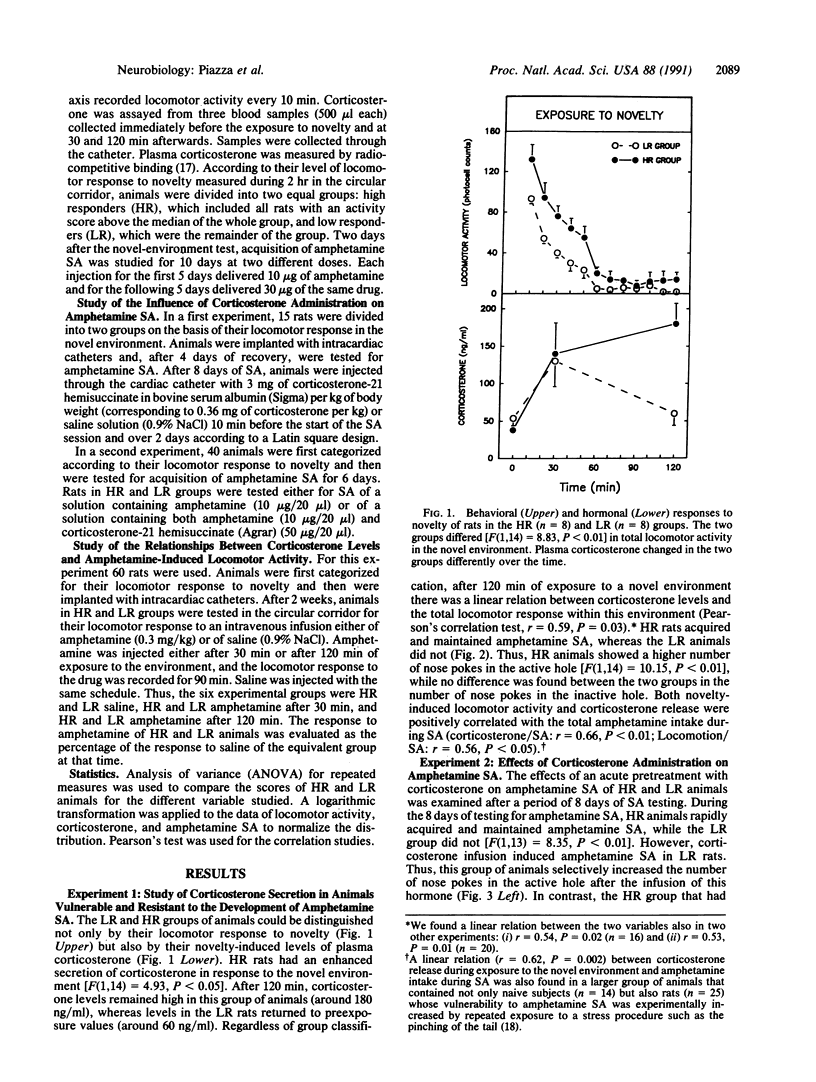Abstract
Individual vulnerability to the reinforcing properties of drugs appears to be an essential characteristic predisposing humans to addiction. In animals, a greater behavioral reactivity to a mild stress, such as exposure to a novel environment, is an index of the vulnerability to acquire amphetamine self-administration. Biological responses to stress as well as behavioral reactivity may predict such a vulnerability. In the present study, rats with a longer duration of corticosterone secretion after exposure to novelty showed facilitation of acquisition of amphetamine self-administration. Furthermore, corticosterone administration in nonpredisposed individuals increased the reinforcing value of the drug and facilitated the acquisition of amphetamine self-administration. These results indicate that the stress-related activity of the hypothalamic-pituitary-adrenal axis may play a role in the pathogenesis of psychostimulant addiction.
Full text
PDF




Selected References
These references are in PubMed. This may not be the complete list of references from this article.
- Antelman S. M., Eichler A. J., Black C. A., Kocan D. Interchangeability of stress and amphetamine in sensitization. Science. 1980 Jan 18;207(4428):329–331. doi: 10.1126/science.7188649. [DOI] [PubMed] [Google Scholar]
- Anton R. F. Urinary free cortisol in psychotic depression. Biol Psychiatry. 1987 Jan;22(1):24–34. doi: 10.1016/0006-3223(87)90126-0. [DOI] [PubMed] [Google Scholar]
- Caggiula A. R., Antelman S. M., Aul E., Knopf S., Edwards D. J. Prior stress attenuates the analgesic response but sensitizes the corticosterone and cortical dopamine responses to stress 10 days later. Psychopharmacology (Berl) 1989;99(2):233–237. doi: 10.1007/BF00442814. [DOI] [PubMed] [Google Scholar]
- Deminiere J. M., Piazza P. V., Le Moal M., Simon H. Experimental approach to individual vulnerability to psychostimulant addiction. Neurosci Biobehav Rev. 1989 Summer-Fall;13(2-3):141–147. doi: 10.1016/s0149-7634(89)80023-5. [DOI] [PubMed] [Google Scholar]
- Evans D. L., Nemeroff C. B. The clinical use of the dexamethasone suppression test in DSM-III affective disorders: correlation with the severe depressive subtypes of melancholia and psychosis. J Psychiatr Res. 1987;21(2):185–194. doi: 10.1016/0022-3956(87)90018-5. [DOI] [PubMed] [Google Scholar]
- Gawin F. H., Ellinwood E. H., Jr Cocaine and other stimulants. Actions, abuse, and treatment. N Engl J Med. 1988 May 5;318(18):1173–1182. doi: 10.1056/NEJM198805053181806. [DOI] [PubMed] [Google Scholar]
- Härfstrand A., Fuxe K., Cintra A., Agnati L. F., Zini I., Wikström A. C., Okret S., Yu Z. Y., Goldstein M., Steinbusch H. Glucocorticoid receptor immunoreactivity in monoaminergic neurons of rat brain. Proc Natl Acad Sci U S A. 1986 Dec;83(24):9779–9783. doi: 10.1073/pnas.83.24.9779. [DOI] [PMC free article] [PubMed] [Google Scholar]
- Imperato A., Puglisi-Allegra S., Casolini P., Zocchi A., Angelucci L. Stress-induced enhancement of dopamine and acetylcholine release in limbic structures: role of corticosterone. Eur J Pharmacol. 1989 Jun 20;165(2-3):337–338. doi: 10.1016/0014-2999(89)90735-8. [DOI] [PubMed] [Google Scholar]
- Joëls M., de Kloet E. R. Effects of glucocorticoids and norepinephrine on the excitability in the hippocampus. Science. 1989 Sep 29;245(4925):1502–1505. doi: 10.1126/science.2781292. [DOI] [PubMed] [Google Scholar]
- Keller-Wood M. E., Dallman M. F. Corticosteroid inhibition of ACTH secretion. Endocr Rev. 1984 Winter;5(1):1–24. doi: 10.1210/edrv-5-1-1. [DOI] [PubMed] [Google Scholar]
- Kerr D. S., Campbell L. W., Hao S. Y., Landfield P. W. Corticosteroid modulation of hippocampal potentials: increased effect with aging. Science. 1989 Sep 29;245(4925):1505–1509. doi: 10.1126/science.2781293. [DOI] [PubMed] [Google Scholar]
- Koob G. F., Bloom F. E. Cellular and molecular mechanisms of drug dependence. Science. 1988 Nov 4;242(4879):715–723. doi: 10.1126/science.2903550. [DOI] [PubMed] [Google Scholar]
- Le Moal M., Stinus L., Simon H. Increased sensitivity to (+)amphetamine self-administered by rats following meso-cortico-limbic dopamine neurone destruction. Nature. 1979 Jul 12;280(5718):156–158. doi: 10.1038/280156a0. [DOI] [PubMed] [Google Scholar]
- Murphy B. E. Some studies of the protein-binding of steroids and their application to the routine micro and ultramicro measurement of various steroids in body fluids by competitive protein-binding radioassay. J Clin Endocrinol Metab. 1967 Jul;27(7):973–990. doi: 10.1210/jcem-27-7-973. [DOI] [PubMed] [Google Scholar]
- Pfaff D. W., Silva M. T., Weiss J. M. Telemetered recording of hormone effects on hippocampal neurons. Science. 1971 Apr 23;172(3981):394–395. doi: 10.1126/science.172.3981.394. [DOI] [PubMed] [Google Scholar]
- Piazza P. V., Deminiere J. M., le Moal M., Simon H. Stress- and pharmacologically-induced behavioral sensitization increases vulnerability to acquisition of amphetamine self-administration. Brain Res. 1990 Apr 23;514(1):22–26. doi: 10.1016/0006-8993(90)90431-a. [DOI] [PubMed] [Google Scholar]
- Piazza P. V., Deminière J. M., Le Moal M., Simon H. Factors that predict individual vulnerability to amphetamine self-administration. Science. 1989 Sep 29;245(4925):1511–1513. doi: 10.1126/science.2781295. [DOI] [PubMed] [Google Scholar]
- Rivet J. M., Stinus L., LeMoal M., Mormède P. Behavioral sensitization to amphetamine is dependent on corticosteroid receptor activation. Brain Res. 1989 Sep 25;498(1):149–153. doi: 10.1016/0006-8993(89)90411-3. [DOI] [PubMed] [Google Scholar]
- Robinson T. E., Becker J. B. Enduring changes in brain and behavior produced by chronic amphetamine administration: a review and evaluation of animal models of amphetamine psychosis. Brain Res. 1986 Jun;396(2):157–198. doi: 10.1016/s0006-8993(86)80193-7. [DOI] [PubMed] [Google Scholar]
- Robinson T. E., Jurson P. A., Bennett J. A., Bentgen K. M. Persistent sensitization of dopamine neurotransmission in ventral striatum (nucleus accumbens) produced by prior experience with (+)-amphetamine: a microdialysis study in freely moving rats. Brain Res. 1988 Oct 18;462(2):211–222. doi: 10.1016/0006-8993(88)90549-5. [DOI] [PubMed] [Google Scholar]
- Sapolsky R. M., Krey L. C., McEwen B. S. The neuroendocrinology of stress and aging: the glucocorticoid cascade hypothesis. Endocr Rev. 1986 Aug;7(3):284–301. doi: 10.1210/edrv-7-3-284. [DOI] [PubMed] [Google Scholar]
- Sloviter R. S., Valiquette G., Abrams G. M., Ronk E. C., Sollas A. L., Paul L. A., Neubort S. Selective loss of hippocampal granule cells in the mature rat brain after adrenalectomy. Science. 1989 Jan 27;243(4890):535–538. doi: 10.1126/science.2911756. [DOI] [PubMed] [Google Scholar]
- Swerdlow N. R., Koob G. F. Restrained rats learn amphetamine-conditioned locomotion, but not place preference. Psychopharmacology (Berl) 1984;84(2):163–166. doi: 10.1007/BF00427440. [DOI] [PubMed] [Google Scholar]
- de Wit H., Uhlenhuth E. H., Johanson C. E. Individual differences in the reinforcing and subjective effects of amphetamine and diazepam. Drug Alcohol Depend. 1986 Feb;16(4):341–360. doi: 10.1016/0376-8716(86)90068-2. [DOI] [PubMed] [Google Scholar]


